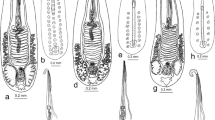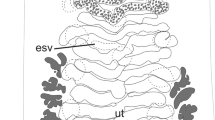Abstract
A new genus and species, Thrinascotrema brisbanica, is proposed to accommodate a plagiorchiidan trematode parasitic in the stomach of the freshwater turtle Elseya latisternum. The distinctive taxonomic features of the parasite are the shape and extent of the excretory bladder, and the stenostomate arrangement of the excretory collecting ducts in the adult, cercaria and metacercaria together with a cercarial protonephridial formula of 2(12+12+12)+(12+12+12). The life-cycle is three- host and aquatic. The pulmonate snail Glyptophysa gibbosa served as both a first and second intermediate host and tadpoles of Limnodynastes peronii, Adelotus brevis and Bufo marinus, and the snail Austropeplea lessoni also served as second intermediate hosts. Eggs were fully embryonated and infective when laid, but did not hatch until eaten by the snail. Cercariae first emerged 55 days after infection at 24-28 °C. They were sluggish swimmers and survived for about 48 hr. They attached firmly to the skin of snails and tadpoles on contact and began to penetrate the skin after a short exploratory migration. Metacercariae survived in snails and tadpoles for at least 3 months. It is concluded that Thrinascotrema is best placed within a new family, the Thrinascotrematidae (Digenea: Plagiorchiida), based on the unusual morphology of the excretory system.
Similar content being viewed by others
References
Jue Sue, L. & Platt, T. R. (1998) Redescription and life-cycle of Sigmapera cincta Nicoll, 1918 (Digenea: Plagiorchiidae) a para-site of Australian freshwater turtles. Systematic Parasitology, 39, 223–235.
Odening, K. (1968) Exkretionssystem und systematische Stellung der Trematodengattungen Anchitrema, Cephalogonimus, Ency-clometra, Mesotretes, Omphalometra und Urotrema. Monats-berichte der Deutschen Akademie der Wissenschaften zu Berlin, 10, 482–498.
Odening, K. (1971) Möglichkeiten der Herstellung des bisher un-bekannten Zusammenhangs von Cercarien und adulten Trema-toden mit Hilfe detaillierter Kenntnisse des Exkretionssystems nebst Ausfuhrüngen zum weiteren Ausbau des Systems der Plagiorchiata. In: Odening, K. (Ed.) Perspektiven der Cercarien-forschung. Parasitologische Schriftenreihe, 21, 57–72.
Sewell, R. B. S. (1922) Cercariae indicae. Indian Journal of Medical Research, 10, (Suppl.), 370 pp.
Yamaguti, S. (1971) Synopsis of digenetic trematodes of vertebrates. Tokyo: Keigaku Press, Vol. 1, 1074 pp.; Vol. 2, 2349 plates.
Author information
Authors and Affiliations
Rights and permissions
About this article
Cite this article
Sue, L.J., Platt, T.R. Description and life-cycle of Thrinascotrema brisbanica n. g., n. sp. (Digenea: Plagiorchiida), a parasite of the freshwater turtle Elseya latisternum from Australia, and the erection of the family Thrinascotrematidae. Syst Parasitol 43, 217–227 (1999). https://doi.org/10.1023/A:1006145117356
Issue Date:
DOI: https://doi.org/10.1023/A:1006145117356




